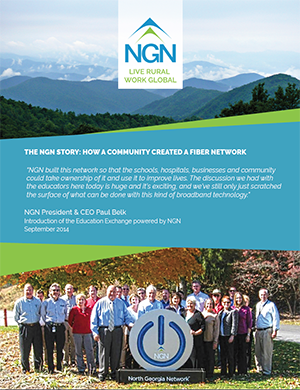
Does your healthcare facility have a telemedicine program in place, or is your team considering one? Made possible by real-time videoconferencing and powered by high speed broadband, telehealth has grown rapidly in recent years – with the market projected to reach $9.35 billion by 2021[1]. According to a recent report on “Anticipating Economic Returns of Rural Telehealth” by NTCA—The Rural Broadband Association, “Telemedicine has the potential to improve the quality, cost and availability of healthcare in rural areas” – helping to offset the health disparity between rural and non-rural Americans, which is primarily a result of demographics and limited access to healthcare.[2]
The report further breaks down the benefits of rural telehealth into quantifiable and non-quantifiable benefits. Those benefits that are easily measured include transportation cost savings, lost wages savings, hospital cost savings and increased revenues to local labs and pharmacies. Benefits that are harder to measure but no less real consist of access to specialists, timeliness, comfort, transportation, provider benefits and improved outcomes.
Below we take a deeper look at the benefits mentioned above that are specific to healthcare facilities and medical practices in rural communities.
Providing Local Access to Specialty Care
In some rural areas, residents live a great distance away from medical facilities and it is a financial hardship for them to secure transportation to receive medical care – especially when a specialist is needed. Telemedicine has created a way for physicians to consult with patients without being in the same room. Patients can receive the specialty care they need at your local facility without traveling to an urban hospital or waiting days, or even weeks, for a specialist to visit your community for an in-person appointment.
This accessibility allows the patient to receive treatment so the condition doesn’t worsen or perhaps remain untreated. It also decreases overall medical costs and resources for your medical facility by reducing readmissions and unnecessary ER visits. At the same time, it keeps lab work, prescription fulfillment, and procedures such as MRIs and CT scans local to your facility.
Maximizing the Time of the Healthcare Provider
According to a recent study by the Association of American Medical Colleges, the U.S. will experience a shortage of physicians over the next decade, with physician demand across all disciplines continuing to grow faster than supply. This trend could lead to a predicted shortfall of between 40,800 and 104,900 physicians by 2030.[3] This shortage may have an even greater significance in rural areas, where approximately 21 percent of the U.S. population resides, yet only about 10 percent of the total number of working physicians in the country currently work.[4]
Telemedicine helps to address this shortage by giving healthcare providers the tools to see more patients in the same amount of office hours. This translates into an efficient business model that maximizes the physician’s time and allows practices to offer the same level of medical care with fewer physicians on staff.
Increasing Revenue Potential by Offering Accessible and Convenient Care for Existing Patients
The convenience factor of telemedicine allows patients to receive a physician consultation and diagnosis without taking time off work or leaving their home. It also makes their primary care provider more accessible, even allowing for same-day appointments. In this way, telemedicine programs offer the potential for healthcare facilities to increase revenue, as patients who may not otherwise seek care for a minor illness such as allergies, flu or sore stomach instead visit a “minute clinic” to receive immediate medical care.
In addition, telemedicine programs can increase revenues by:
- Reducing the number of no-show/late appointments
- Promoting greater continuity of care between the healthcare provider and patient
- Expanding business to include longer hours and weekend care
- Allowing physicians to provide a second opinion on a prognosis for non-patients.
NGN’s Fiber Network Infrastructure Supports Telemedicine Programs
NGN provides the broadband infrastructure required to make remote consultation by video conference possible.
In the “Anticipating Economic Returns of Rural Telehealth” report referenced above, the author states that “Rural telemedicine’s ultimate role in addressing the significant health problems inherent to rural areas will depend in large part on the availability of an underlying future-proof, fiber-based broadband infrastructure.” NGN is committed to filling this need and supporting initiatives that provide the best healthcare possible.
For more information on developing a telemedicine program, the American Telemedicine Association provides a variety of resources here. To discuss optimizing the broadband capabilities at your healthcare facility or medical practice, please contact us at info@ngn.coop or 706-754-5323.
[1] https://www.medgadget.com/2017/07/global-telehealth-market-to-reach-9-35-billion-by-2021-growth-factors-top-company-profiles-and-regional-analysis.html
[2] http://www.frs.org/images/AnticipatingEconomicReturnsOfRuralTelehealth.pdf
[3]https://www.aamc.org/newsroom/newsreleases/458074/2016_workforce_projections_04052016.html
[4] http://www.aafp.org/about/policies/all/rural-practice-paper.html
[5] http://www.frs.org/images/AnticipatingEconomicReturnsOfRuralTelehealth.pdf


